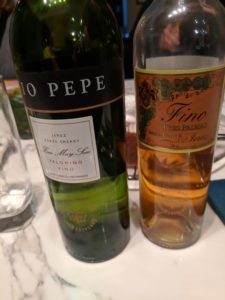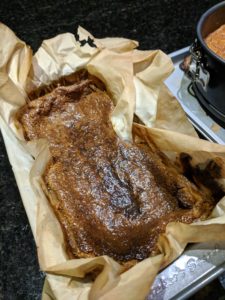 Although Sherry Week was celebrated earlier this month, Sherry deserves to be celebrated all year round. If you associate Sherry with old-fashioned, sweet, cloying wines suitable only for grandma, you need to update your thinking. This fortified wine (meaning that alcoholic spirit has been added to it) offers up a diversity of styles, is at home with a wide range of foods and is usually well priced. In other words, it is sheer perfection in a glass!
Although Sherry Week was celebrated earlier this month, Sherry deserves to be celebrated all year round. If you associate Sherry with old-fashioned, sweet, cloying wines suitable only for grandma, you need to update your thinking. This fortified wine (meaning that alcoholic spirit has been added to it) offers up a diversity of styles, is at home with a wide range of foods and is usually well priced. In other words, it is sheer perfection in a glass!
Yes, Sherry can be an unusual wine if you are unfamiliar with it. But if you know what to expect and go in with an open mind, you just might be pleasantly surprised. Such was the case when we hosted our friends for dinner during which they tentatively tasted two Fino Sherries and were immediately hooked.
Overall, Sherry is quite complex due to its lengthy and complicated production process. Without going into too elaborate of an explanation, it is enough to know that 1) Sherry is produced solely in the Jerez region of Spain and 2) that its various styles can be categorized as being either aged biologically (under the influence of an indigenous yeast called flor, which protects the wine from oxidation) and those that are aged oxidatively (without flor).
Biologically aged Sherries include Finos and Manzanillas (a subset of Finos, which come from the seaside town of Sanlúcar de Barrameda). As fortified wines, these types of Sherries are on the lower side of the alcoholic range, generally coming in at 15-16% ABV (alcohol by volume), so they are not much higher than that California Cab you drank last night. More importantly, thanks to their exposure to flor, these delicate Sherries display a unique yeasty and lightly nutty aroma and flavor profile.
 On their own, their unique characteristics can be a bit overwhelming, but when paired with food, they really sing. Taking inspiration from the wines themselves as well as our recent return from Spain, I put together an assortment of small dishes – tapas – to enjoy with our friends:
On their own, their unique characteristics can be a bit overwhelming, but when paired with food, they really sing. Taking inspiration from the wines themselves as well as our recent return from Spain, I put together an assortment of small dishes – tapas – to enjoy with our friends:
- An unctuous, fuet sausage
- Firm and nutty Manchego cheese (aged for 12 months)
- Patatas Bravas – crispy potatoes with a spicy tomato-based sauce
- Roasted red peppers in olive oil
- Shrimp in garlic and oil
- Pan con tomate (seen in photo)
- Anchovies marinated in vinegar
Once it was obvious that our friends were on board with the Sherries, we dug into our meal with gusto, savoring the interaction of the two wines with the various plates and having fun choosing which wine we preferred with which dish.
And, while our meal was limited to Finos, the breadth of Sherry styles provides even greater opportunity for experimentation with options such as Amontillado and Oloroso, both of which are deeper in color, increasingly fuller in body and nuttier in taste. Again, this is an over-simplification; for more details on Sherry and its various styles, check out this website from the Consejo Regulador de las Denominaciones de Origen “Jerez-Xérès-Sherry”.
 Finally, as we switched from a savory to a sweet focus, we enjoyed a PX (Pedro Ximenez) dessert-style Sherry thanks to the generosity of our dinner guests. These full-bodied stickies offer up notes such as molasses, toffee and burnt sugar, and served as the perfect accompaniment to the Catalan cheesecake I baked. If you’ve never had Catalan cheesecake, I like to think of it as the love child of flan and traditional cheesecake, which results in a much creamier, silkier texture.
Finally, as we switched from a savory to a sweet focus, we enjoyed a PX (Pedro Ximenez) dessert-style Sherry thanks to the generosity of our dinner guests. These full-bodied stickies offer up notes such as molasses, toffee and burnt sugar, and served as the perfect accompaniment to the Catalan cheesecake I baked. If you’ve never had Catalan cheesecake, I like to think of it as the love child of flan and traditional cheesecake, which results in a much creamier, silkier texture.
NB: I was determined to find an authentic recipe, so I watched this video, did some conversion calculations and hoped for the best. We were not disappointed! You can check out my version of the recipe.
TASTING NOTES
Tio Pepe Palomino Fino NV, Jerez, Spain, $20.00
Pale in color. Fresh, with slight yeasty and light nutty notes on both the nose and palate, culminating in long length.
Tres Palmas 2016, Fino, Jerez, Spain, $80.00
This wine starts its life as Tio Pepe, but the best barrel(s) are selected for Tres Palmas designation – those that are considered to be of a higher quality. IT has spent an average of ten years aging in American oak casks after having spent time in the initial solera. It was deeper in color, fuller-bodied, richer and nuttier than the Tio Pepe. It was truly lovely!
